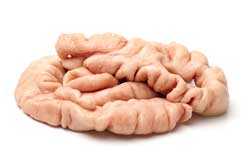Preparing Chitlins Safely

Chitlins are a traditional Southern food served during winter holidays. If you’re getting ready to cook chitlins, sometimes called chitterlings, it’s important to handle and cook these pork intestines the right way.
If certain steps are not followed during preparation, harmful germs in the raw pork intestines can infect people. Young children are the most likely to get sick, so you should take special care to keep them safe when preparing chitlins.
Practice Safety When Preparing Chitlins
You can contact harmful germs like Yersinia enterocolitica while preparing chitlins. You can reduce the chance of getting sick by buying chitlins that are already cooked. You also can reduce the chance of spreading germs to children by buying already cooked chitlins and by washing your hands thoroughly before you touch children and things they may put in their mouth. If you prepare chitlins yourself, make sure to follow these tips:
Getting Ready

Before you begin, take out everything you’ll need to prepare chitlins and to clean up when you’re done.

Don’t serve chitlins until they are well cooked.
- Keep children out of the kitchen while you prepare chitlins.
- Ask someone else to watch children, especially infants, so you don’t accidently spread germs from the chitlins to them.
- Before you begin, take out everything you’ll need to prepare the chitlins and to clean up when you’re done—chopping boards, knives and other utensils, pots and pans, measuring cups and spoons, ingredients and seasonings, bleach solution, paper towels—so your hands don’t spread germs around the kitchen.
Preparing Chitlins
- Buy already cooked chitlins when possible because they should be safer to handle.
- Freeze raw chitlins unless you plan to clean and cook them within 2 days.
- Thaw raw frozen chitlins in the refrigerator in a completely covered bowl or bucket to prevent drips that can contaminate the refrigerator and any food or containers in it. Cook raw chitlins within 2 days after thawing them.
- Boil raw chitlins in water for at least 5 minutes before cleaning to reduce germs that may get on your hands, counter, and utensils while you are cleaning the chitlins.
- Boil and simmer chitlins until well cooked and tender before serving. Don’t taste them until they are well cooked.
Cleaning Up
- Wash your hands thoroughly with soap and running warm water for at least 20 seconds after preparing chitlins and before touching other food or touching children or their toys, bottles, or pacifiers.
- Use a solution of 1 tablespoon of bleach to 1 gallon of water to wash anything that may have been touched by your hands, raw chitlins, and their juice.
- This may include chopping boards, knives and other utensils, refrigerator (including shelves, doors, and handles), countertop, stovetop (including knobs and switches), cabinets and drawers (and their handles), dishwasher front, sink (including the basin, drain, handles, and spout), floor, and light switches.
- Pots, pans, lids, buckets, and utensils can be washed on the hot cycle of the dishwasher or by hand in hot, soapy water.
- Consider using paper towels to clean so any germs that get on them are thrown away. If you use cloth towels, wash them in the washing machine using hot water.
- Flood or spray the surface with the bleach solution and allow the solution to stand for several minutes. Then rinse with plain water and let it air dry or pat it dry with paper towels.
Could Somebody Be Sick?

People can get sick from eating or touching raw or undercooked pork that is contaminated with the germ Yersinia enterocolitica. This bacteria causes a disease called yersiniosis. Young children are more likely to get sick with yersiniosis if people preparing chitlins don’t wash their hands carefully before touching children or items that children put in their mouths, such as toys, bottles, and pacifiers.
Symptoms of yersiniosis can vary depending on the age of the sick person. Common symptoms in young children are:
- Fever
- Abdominal pain
- Diarrhea that may be bloody
These symptoms usually develop 4 to 7 days after contact with the bacteria and may last 1 to 3 weeks or longer. Symptoms in older children and adults may include fever and pain on the right side of the abdomen and may be confused with appendicitis.
- Page last reviewed: December 19, 2016
- Page last updated: December 19, 2016
- Content source:
- National Center for Emerging and Zoonotic Infectious Diseases
- Page maintained by: Office of the Associate Director for Communication, Digital Media Branch, Division of Public Affairs




 ShareCompartir
ShareCompartir